标签:sha length triggers 解决 文本框 控件 hit end virtual
1、ValidationRule 验证
ValidationRule:是通过ValidationRule中的的Validate方法来验证我们绑定的属性。所以我们的用法是继承ValidationRule,重写他的Validate方法。示例
public class RequiredRule : ValidationRule
{
public override ValidationResult Validate(object value, CultureInfo cultureInfo)
{
if (value == null)
return new ValidationResult(false, "不能为空值!");
if (string.IsNullOrEmpty(value.ToString()))
return new ValidationResult(false, "不能为空字符串!");
return new ValidationResult(true, null);
}
}
而XAML中需要把错误信息显示出来。
<Window.Resources>
<ControlTemplate x:Key="ErrorTemplate">
<Border BorderBrush="Red" BorderThickness="1">
<AdornedElementPlaceholder/>
</Border>
</ControlTemplate>
<Style TargetType="TextBox">
<Setter Property="Validation.ErrorTemplate" Value="{StaticResource ErrorTemplate}">
</Setter>
<Style.Triggers>
<Trigger Property="Validation.HasError" Value="True">
<Setter Property="ToolTip" Value="{Binding RelativeSource={RelativeSource Self}, Path=(Validation.Errors)[0].ErrorContent}"/>
</Trigger>
</Style.Triggers>
</Style>
</Window.Resources>
<StackPanel>
<TextBlock Text="姓名"/>
<TextBox>
<TextBox.Text>
<Binding Path="Name" UpdateSourceTrigger="PropertyChanged" ValidatesOnDataErrors="True">
<Binding.ValidationRules>
<ValidationRules:RequiredRule/>
</Binding.ValidationRules>
</Binding>
</TextBox.Text>
</TextBox>
<TextBlock Text="年龄"/>
<TextBox >
<TextBox.Text>
<Binding Path="Age" UpdateSourceTrigger="PropertyChanged" ValidatesOnDataErrors="True">
<Binding.ValidationRules>
<ValidationRules:GreaterThanRule Number="10"/>
</Binding.ValidationRules>
</Binding>
</TextBox.Text>
</TextBox>
</StackPanel>
这样显示的错误信息就会以 ToolTip和红色边框的形式显示出来。但这边如果又在TextBox里面设置ToolTip那么就会优先选择TextBox里的,也就是Style中的ToolTip遇到错误信息是不会显示出来的,而是显示TextBox中的ToolTip。所以我们可以改善一下显示的模版来解决这个问题。
<ControlTemplate x:Key="ErrorTemplate">
<DockPanel LastChildFill="true">
<Border Background="Red" DockPanel.Dock="right" Margin="5,0,0,0" Width="20" Height="20" CornerRadius="10"
ToolTip="{Binding ElementName=customAdorner, Path=AdornedElement.(Validation.Errors)[0].ErrorContent}">
<TextBlock Text="!" VerticalAlignment="center" HorizontalAlignment="center" FontWeight="Bold" Foreground="white">
</TextBlock>
</Border>
<AdornedElementPlaceholder Name="customAdorner" VerticalAlignment="Center" >
<Border BorderBrush="red" BorderThickness="1" />
</AdornedElementPlaceholder>
</DockPanel>
</ControlTemplate>
Exception :我们xaml中绑定的对象是属性。所以Exception验证,就是通过属性的改变来判断是否正常。如:
public int Age
{
get { return _age; }
set
{
if (value > 200)
{
throw new Exception("年龄不能大于200");
}
_age = value;
}
}
同样跑出的异常在Xaml中也要显示下。XAML同上。这种方式就会破坏POCO的设计原则。
IDataErrorInfo:这个验证是通过我们的实体对象继承IDataErrorInfo来实现的。这里声明的this索引器来访问类的成员。
public class BaseDataErrorInfo : IDataErrorInfo
{
private string _error;
public string this[string columnName]
{
get { return GetErrorFor(columnName); }
}
public string Error
{
get { return _error; }
set { _error = value; }
}
public virtual string GetErrorFor(string columnName)
{
return string.Empty;
}
}
public class Person : BaseDataErrorInfo
{
public string Name { get; set; }
public override string GetErrorFor(string columnName)
{
if (columnName == "Name")
if (string.IsNullOrEmpty(Name))
return "Name 不能为空";
return base.GetErrorFor(columnName);
}
}
XAML同上。
这里我即不想污染实体类,又想实现一个通用的Validate。我想通过我xaml绑定的属性和它所属的控件。来显示ToolTip。
public abstract class Validator : FrameworkElement
{
static Validator()
{
DefaultStyleKeyProperty.OverrideMetadata(typeof(Validator), new FrameworkPropertyMetadata(typeof(Validator)));
}
public virtual string ErrorMessage { get { return string.Empty; } }
public abstract bool InitialValidation();
public FrameworkElement ElementName
{
get { return (FrameworkElement)GetValue(ElementNameProperty); }
set { SetValue(ElementNameProperty, value); }
}
// Using a DependencyProperty as the backing store for ElementName. This enables animation, styling, binding, etc...
public static readonly DependencyProperty ElementNameProperty =
DependencyProperty.Register("ElementName", typeof(FrameworkElement), typeof(Validator), new PropertyMetadata(null));
public object Source
{
get { return (object)GetValue(SourceProperty); }
set { SetValue(SourceProperty, value); }
}
// Using a DependencyProperty as the backing store for Source. This enables animation, styling, binding, etc...
public static readonly DependencyProperty SourceProperty =
DependencyProperty.Register("Source", typeof(object), typeof(Validator), new UIPropertyMetadata(new PropertyChangedCallback(ValidPropertyPropertyChanged)));
private static void ValidPropertyPropertyChanged(DependencyObject d, DependencyPropertyChangedEventArgs e)
{
var validator = d as Validator;
if (validator != null)
validator.SetSourceFromProperty();
if (string.IsNullOrEmpty(e.NewValue.ToString()))
{
if (validator != null)
{
validator.IsValid = validator.InitialValidation();
if (validator.ElementName.DataContext != null)
validator.ShowToolTip();
validator.IsValid = false;
}
}
}
private void ShowToolTip()
{
if (IsValid)
{
timer = new DispatcherTimer();
timer.Interval = TimeSpan.FromSeconds(1.5);
_toolTip = new ToolTip();
_toolTip.StaysOpen = true;
_toolTip.PlacementTarget = ElementName;
_toolTip.Placement = PlacementMode.Right;
_toolTip.Content = ErrorMessage;
_toolTip.IsOpen = true;
timer.Tick += (sender, args) =>
{
_toolTip.IsOpen = false;
timer.Stop();
};
timer.Start();
}
}
private void SetSourceFromProperty()
{
var expression = this.GetBindingExpression(SourceProperty);
if (expression != null && this.ElementName == null)
this.SetValue(Validator.ElementNameProperty, expression.DataItem as FrameworkElement);
}
private ToolTip _toolTip;
private DispatcherTimer timer;
public bool IsValid { get; set; }
}
这是一个简单的Validate基类。提供思想。功能不完善。
然后继承这个Validator
public class RequiredValidator : Validator
{
public override string ErrorMessage { get { return "不能为空值"; } }
public override bool InitialValidation()
{
if (Source == null)
return false;
return string.IsNullOrEmpty(Source.ToString());
}
}
这里ErrorMessage是显示错误信息。
InitialValidation方法是我们要验证的规则。
关于使用的小例子:
通过代码实现数据绑定,使用的是System.Windows.Data命名空间的Binding类,主要使用Binding类的如下的属性:
在绑定目标控件上使用SetBinding方法添加数据绑定。例如将MyData的Name属性绑定到txtName控件的Text属性上,使用MyColorConverter转换器将MyBindingColor的ColorObject属性绑定到rec控件的Fill属性上:
1: MyData data = new MyData();
2:
3: Binding binding1 = new Binding();
4: binding1.Source = data;
5: binding1.Mode = BindingMode.OneWay;
6: binding1.Path = new PropertyPath("Name");
7:
8: txtName.SetBinding(TextBox.TextProperty, binding1);
9:
10:
11: MyBindingColor color = new MyBindingColor();
12:
13: Binding binding2 = new Binding();
14: binding2.Source = color;
15: binding2.Mode = BindingMode.OneWay;
16: binding2.Path = new PropertyPath("ColorObject");
17: binding2.Converter = new MyColorConverter();
18:
19: rec.SetBinding(Rectangle.FillProperty, binding2);
对于绑定数据的验证,系统采用如下的机制:
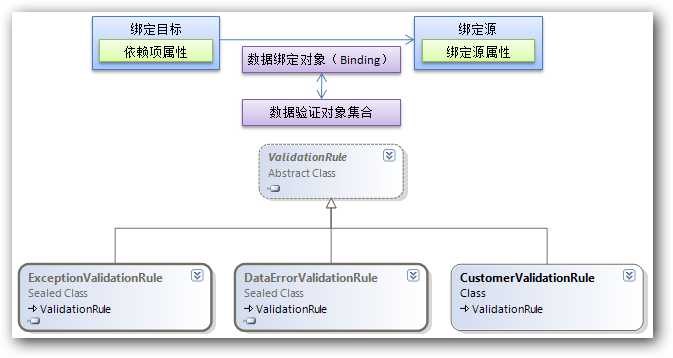
使用 WPF 数据绑定模型可以将 ValidationRules 与 Binding 对象相关联。当绑定目标的属性向绑定源属性传递属性值时(仅限TwoWay模式或OneWayToSource模式),执行ValidationRule中的Validate方法,实现对界面输入数据的验证。
定义验证可以采用以下三种:
例如,定义一个学生信息类,要求其学生成绩在0到100间,学生姓名的长度在2到10个字符间:
1: public class StudentInfoWithValidation : IDataErrorInfo
2: {
3: #region 构造方法
4: public StudentInfoWithValidation()
5: {
6: StudentName = "Tom";
7: Score = 90;
8: }
9: public StudentInfoWithValidation(string m_StudentName,double m_Score)
10: {
11: StudentName = m_StudentName;
12: Score = m_Score;
13: }
14: #endregion
15:
16: #region 属性
17: public string StudentName
18: {
19: get; set;
20: }
21: public double Score
22: {
23: get; set;
24: }
25: #endregion
26:
27: #region 实现IDataErrorInfo接口的成员
28: public string Error
29: {
30: get
31: {
32: return null;
33: }
34: }
35:
36: public string this[string columnName]
37: {
38: get
39: {
40: string result = null;
41:
42: switch (columnName)
43: {
44: case "StudentName":
45: // 设置StudentName属性的验证规则
46: int len = StudentName.Length;
47: if (len < 2 || len > 10)
48: {
49: result = "StudentName length must between 2 and 10";
50: }
51: break;
52: case "Score":
53: // 设置Score属性的验证规则
54: if (Score < 0 || Score > 100)
55: {
56: result = "Score must between 0 and 100";
57: }
58: break;
59: }
60:
61: return result;
62: }
63: }
64: #endregion
65: }
在界面上,定义两个TextBox绑定到StudentName和Score两个属性上,并设置其采用DataErrorValidationRule:
1: <Window x:Class="WPFDataBindingDemo.WinDataErrorValidationRuleDemo"
2: xmlns="http://schemas.microsoft.com/winfx/2006/xaml/presentation"
3: xmlns:x="http://schemas.microsoft.com/winfx/2006/xaml"
4: xmlns:local="clr-namespace:WPFDataBindingDemo"
5: Title="WinDataErrorValidationRuleDemo" Height="154" Width="300">
6: <Canvas Height="116" x:Name="mainCanvas">
7: <Canvas.Resources>
8: <local:StudentInfoWithValidation x:Key="myData" />
9: </Canvas.Resources>
10: <Canvas.DataContext>
11: <Binding Source="{StaticResource myData}" />
12: </Canvas.DataContext>
13: <Label Canvas.Left="10" Canvas.Top="10" Height="28" Name="label1" Width="120">StudentName:</Label>
14: <Label Canvas.Left="10" Canvas.Top="36" Height="28" Name="label2" Width="120">Score:</Label>
15: <TextBox Canvas.Left="136" Canvas.Top="12" Height="23" Name="textBox1" Width="120">
16: <TextBox.Text>
17: <Binding Path="StudentName"
18: Mode="TwoWay"
19: UpdateSourceTrigger="PropertyChanged"
20: ValidatesOnDataErrors="True" />
21: </TextBox.Text>
22: </TextBox>
23: <TextBox Canvas.Left="136" Canvas.Top="41" Height="23" Name="textBox2" Width="120">
24: <TextBox.Text>
25: <Binding Path="Score" Mode="TwoWay" UpdateSourceTrigger="PropertyChanged">
26: <!--与上一个TextBox控件的写法作用相同-->
27: <Binding.ValidationRules>
28: <DataErrorValidationRule />
29: </Binding.ValidationRules>
30: </Binding>
31: </TextBox.Text>
32: </TextBox>
33: <Button Canvas.Left="12" Canvas.Top="79" Height="23" Name="button1" Width="118" Click="button1_Click">Get Student Info</Button>
34: <Button Canvas.Left="136" Canvas.Top="79" Height="23" Name="button2" Width="118" Click="button2_Click">Get Validate State</Button>
35: </Canvas>
36: </Window>
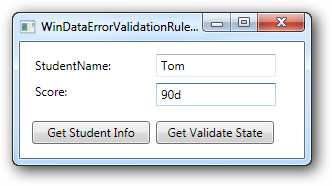
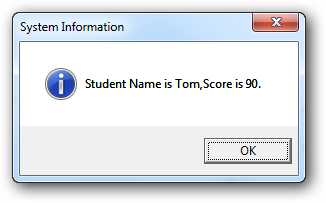
从执行的结果上来看,当验证出现错误(即索引器属性返回的字符串不为空时),系统默认给出一种验证错误的显示方式(控件以红色边框包围),但是需注意两点:
例如上例中,对于Score对应的TextBox,再加入ExceptionValidationRule:
1: <TextBox Canvas.Left="136" Canvas.Top="41" Height="23" Name="textBox2" Width="120">
2: <TextBox.Text>
3: <Binding Path="Score" Mode="TwoWay" UpdateSourceTrigger="PropertyChanged">
4: <!--与上一个TextBox控件的写法作用相同-->
5: <Binding.ValidationRules>
6: <DataErrorValidationRule />
7: <ExceptionValidationRule />
8: </Binding.ValidationRules>
9: </Binding>
10: </TextBox.Text>
11: </TextBox>
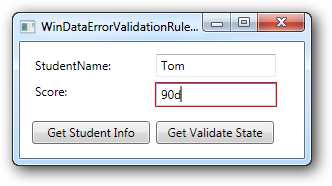
例如,定义一个类,用来验证输入的Email地址是否合法(验证的Email允许为字符串的空值String.Empty,但有输入必须符合Email的格式要求)
在学生类中添加Email可读可写属性(并不做相应的验证,忽略其他重复代码):
1: public string Email
2: {
3: set; get;
4: }
定义一个类,实现Email格式验证:
1: using System.Globalization;
2: using System.Text.RegularExpressions;
3: using System.Windows.Controls;
4:
5: namespace WPFDataBindingDemo
6: {
7: public class EmailValidationRule : ValidationRule
8: {
9: public override ValidationResult Validate(object value, CultureInfo cultureInfo)
10: {
11: bool isValid = false;
12: string message = null;
13:
14: // 检查输入值不为空,且是字符串
15: if (value != null && value is string)
16: {
17: string email = value.ToString();
18:
19: // 检查输入的字符串是否为String.Empty
20: if (email != string.Empty)
21: {
22: string emailFormartRegex =
23: @"^([\w-\.]+)@((\[[0-9]{1,3}\.[0-9]{1,3}\.[0-9]{1,3}\.)|" +
24: @"(([\w-]+\.)+))([a-zA-Z]{2,4}|[0-9]{1,3})(\]?)$";
25:
26: // 检查输入的字符串是否符合Email格式
27: isValid = Regex.IsMatch(email, emailFormartRegex);
28:
29: if (! isValid)
30: {
31: message = "Input string not match Email Format";
32: }
33: }
34: else
35: {
36: // 输入的字符串为字符串空值时,认为验证通过
37: isValid = true;
38: }
39: }
40: else
41: {
42: message = "Input value is NULL or is not string.";
43: }
44:
45: // 返回验证结果(ValidationResult对象)
46: return new ValidationResult(isValid,message);
47: }
48: }
49: }
在界面上:
1: <TextBox Canvas.Left="104" Canvas.Top="70" Height="23" Name="textBox3" Width="152">
2: <Binding Mode="TwoWay" Path="Email" UpdateSourceTrigger="PropertyChanged">
3: <Binding.ValidationRules>
4: <local:EmailValidationRule />
5: </Binding.ValidationRules>
6: </Binding>
7: </TextBox>
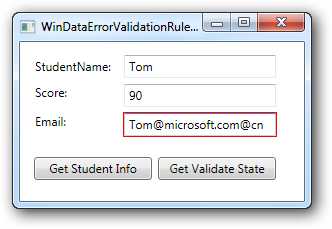
在数据验证错误后,可以通过以下两种方式提供相应的视觉效果:
如果要使输入的控件的外观发生变化,可以使用Style。例如上例中出错,使输入的文本框的背景颜色和字体颜色发生变化,并提供ToolTip显示错误信息,可以定义如下的Style:
1: <Style TargetType="TextBox">
2: <Setter Property="Background" Value="White" />
3: <Setter Property="Foreground" Value="Black" />
4: <Style.Triggers>
5: <Trigger Property="Validation.HasError" Value="True">
6: <Setter Property="Background" Value="#DDD" />
7: <Setter Property="Foreground" Value="Red" />
8: <Setter Property="ToolTip"
9: Value="{Binding RelativeSource={RelativeSource Self},Path=(Validation.Errors)[0].ErrorContent}"/>
10: </Trigger>
11: </Style.Triggers>
12: </Style>
效果如下:
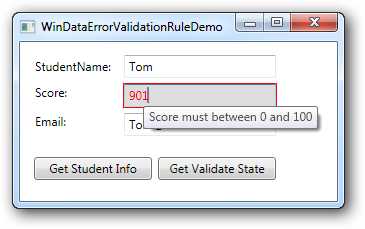
如果要为相应的控件添加一些辅助的控件,可以使用控件模板,如出现验证错误时,不使用系统默认的红色边框,而是在文本框后添加一个红色的星号:
1: <ControlTemplate x:Key="validErrorTextBoxTemplate">
2: <DockPanel>
3: <AdornedElementPlaceholder/>
4: <TextBlock Foreground="Red" FontSize="20">*</TextBlock>
5: </DockPanel>
6: </ControlTemplate>
并在每一个输入的TextBox中添加:
1: Validation.ErrorTemplate="{StaticResource validErrorTextBoxTemplate}"
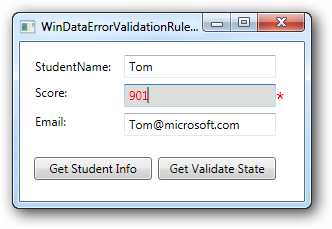
http://www.cnblogs.com/fuchongjundream/p/3844051.html
标签:sha length triggers 解决 文本框 控件 hit end virtual
原文地址:http://www.cnblogs.com/sjqq/p/7762449.html